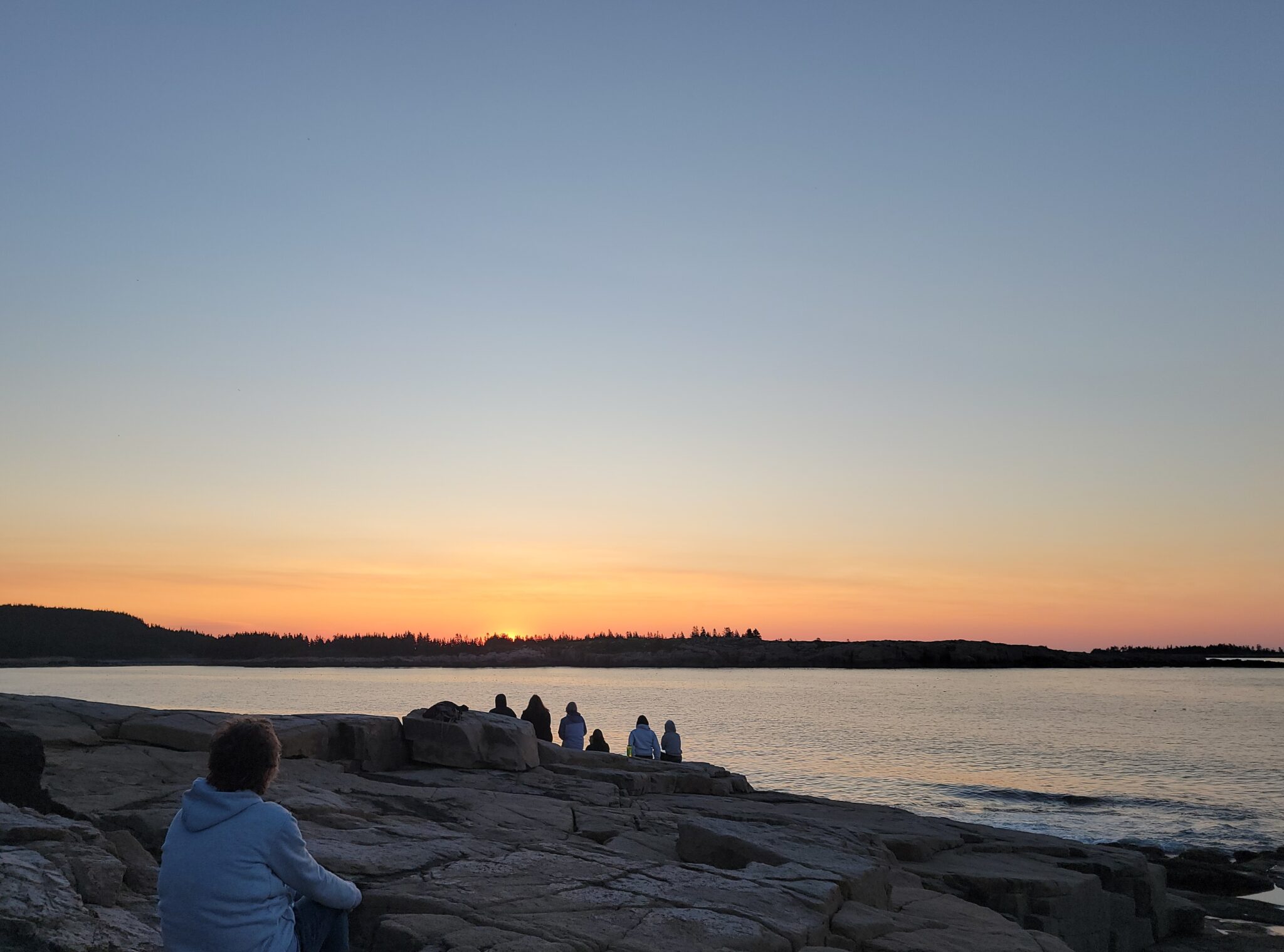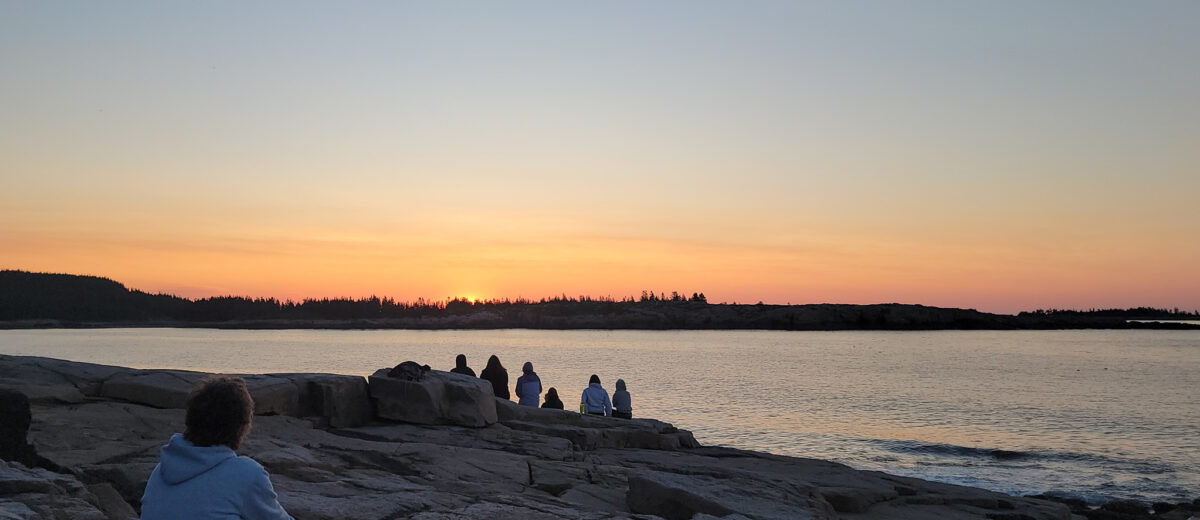by Catherine Schmitt
From the deck of College of the Atlantic’s research vessel Osprey, the shores of Acadia National Park come into sharper focus: the steep cliffs along Schoodic Point’s east side, spruce-tufted islands, and stretches of bluff. On the sandier areas, often near mudflats, are some of the 24 known ancestral Wabanaki cultural sites in Acadia National Park.
Most are coastal mounds of clam shells, their alkaline chemistry working to preserve what would otherwise dissolve over time in the region’s acidic soils. Many areas of shoreline are noticeably eroding. The oldest sites date to around 5,000 years ago – older ones have long since been submerged by rising seas. “People had to move back just like we’ll have to do today,” said archeologist Dr. Bonnie Newsom to the group aboard the boat.
Since 2020, Newsom, a citizen of the Penobscot Nation and professor at the University of Maine, has been re-analyzing and re-interpreting materials collected by archeologists from shell mounds in Acadia decades ago.
We could see how in the upper reaches of the bay and its tidal rivers, wave energy dissipates, and things slow down enough for salt marshes to form. These coastal ecosystems are where Dr. Suzanne Greenlaw of the Houlton Band of Maliseets, now a post-doctoral scientist at Schoodic Institute, has been collaborating with Wabanaki communities and the National Park Service on inventory and assessment of sweetgrass and other culturally important species.
These two efforts had been occurring in parallel with one another, engaging some of the same but mostly different members of Wabanaki communities and partners. The early August gathering was the first time the two groups had met together: Wabanaki community members, language-speakers, Tribal Historic Preservation Officers, students, and scientists. We spent four days at Schoodic Institute to further efforts for collaborative stewardship of Acadia National Park.
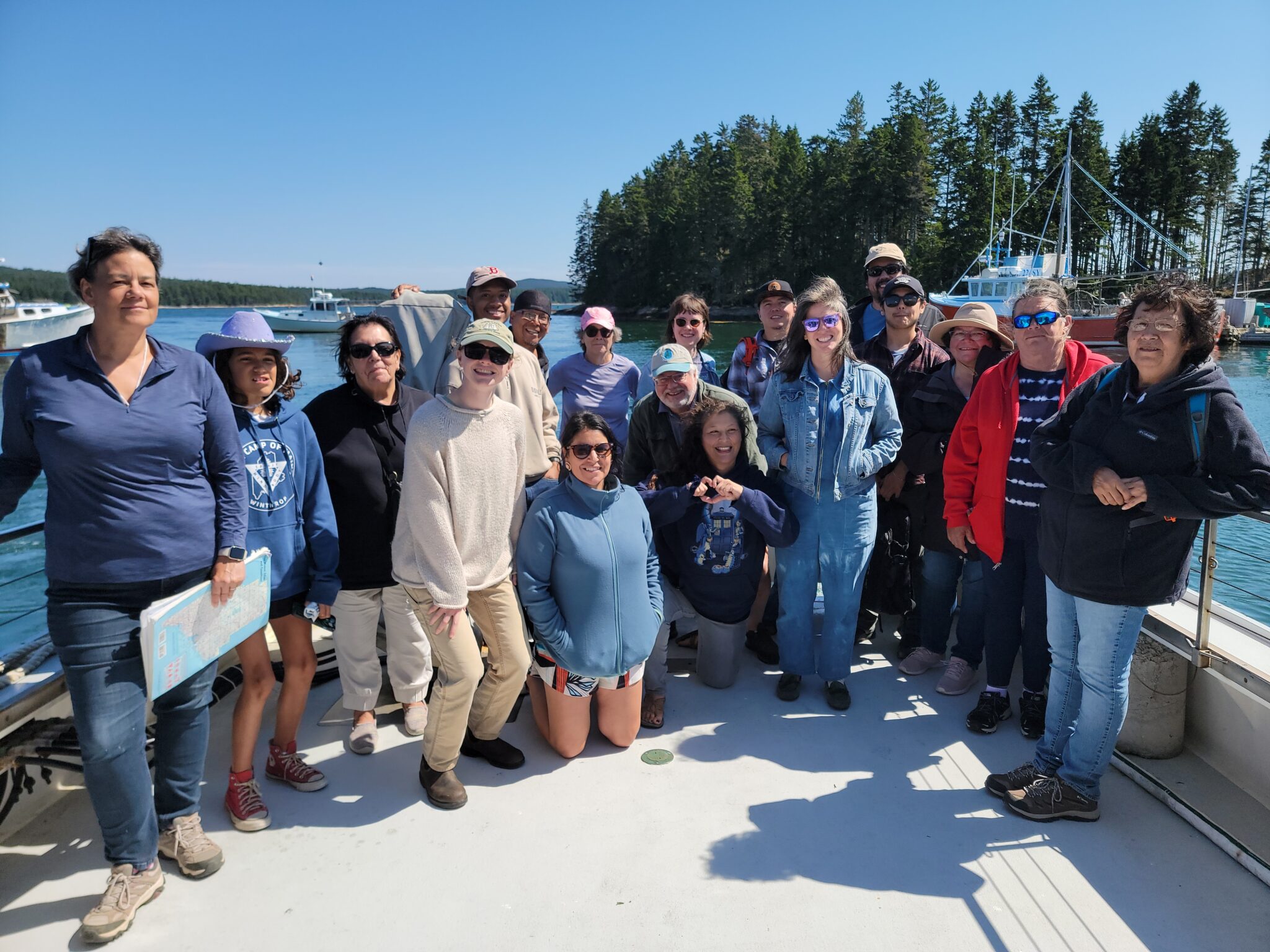
The day before the boat ride, we went to Frazer Point. Newsom described the archeological research at the site, and new ideas for interpretation. We dispersed, first to make an offering to the ancestors, and then to experience the place. Some in our group waded in the water, and others walked the eroding shoreline. The picnic area was crowded with families on bicycles and tourists getting in and out of cars with out-of-state license plates.
The contrast made clear that not everyone is a visitor in Acadia. When Wabanaki people are in the park, they are home, a place known by their ancestors, generation after generation, since “time immemorial” – a time before memory. For thousands of years, Wabanaki families came to the coasts and bays and mountains and woods for some of the same reasons people come now – the beauty, the breeze, the biological diversity.
Yet for the last few hundred years, Wabanaki families have not been able to practice their cultural traditions in this part of their homeland.
Currently, only limited quantities of fruits, berries, and nuts are allowed to be gathered in Acadia – not fungi or ferns, not cones or other plant parts. In 2016, a change in national policy allowed parks to enter agreements with federally-recognized Tribal Nations for plant harvesting. Rebecca Cole-Will, natural and cultural resource program manager at Acadia, recognized an opportunity for Wabanaki communities to begin a process of reconnection. During discussions, tribal members identified sweetgrass as a plant they wanted to once again gather in Acadia.
Eight years later, after numerous meetings, data collection, Greenlaw’s Ph.D. dissertation, a National Environmental Policy Act-required Environmental Assessment and a “Finding of No Significant Impact,” Acadia National Park is finally developing agreements for sweetgrass gathering, one of only four national parks that have done so.
While in some ways it has been a success, the process was long and onerous, and isn’t feasible on a plant-by-plant basis. The single-plant focus is also contradictory to Wabanaki ways of being. Plants are not separate from their community, from the rest of the plants growing around them, from their environmental context.
This was made clear in the forest, where the group went after visiting Frazer Point. We gathered around an old spruce tree. Maliseet knowledge-keepers demonstrated how to dig for spruce roots (with an approved research permit). As the earth where we dug was covered up and thanks given, we looked around at what else was growing near the tree. Someone shared that one plant, when made into tincture, was strong medicine (“but don’t take too much, just a drop or two”). Another plant had a root that was crunchy and tart (“it will be sweeter after a frost”). On the short walk back from the spruce tree, we tasted blackberries and raspberries, and noted the ripening chokecherries and crabapples.
Multiplying that small area by the tens of thousands of acres of diverse lands and waters protected within Acadia National Park, we began to get a sense of just how many relationships could be restored.
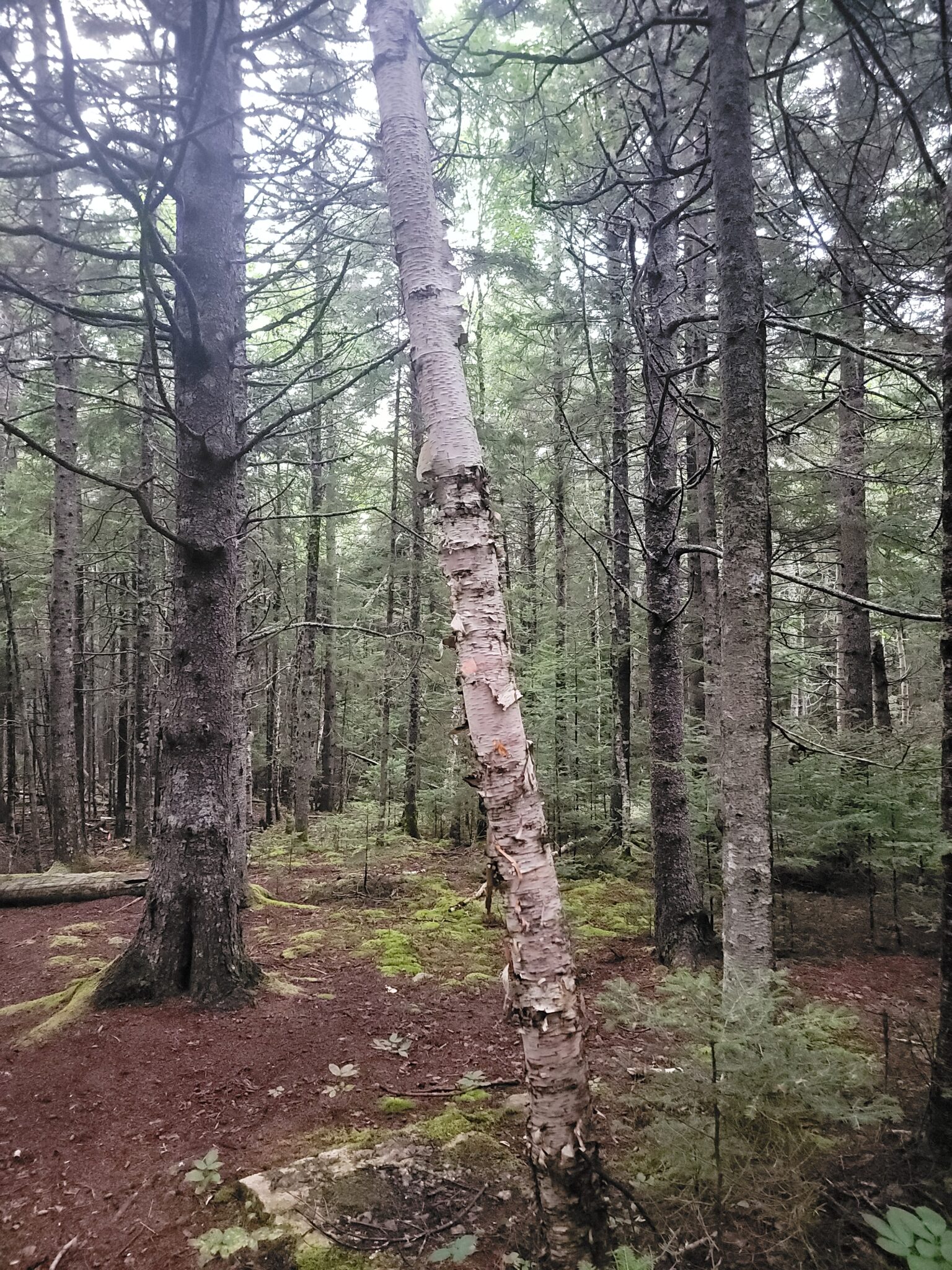
Leadership and staff of the National Park Service, Friends of Acadia, and Schoodic Institute attended parts of the event. Park staff shared maps and data; we all learned how to use split spruce root to stitch birchbark into a container. The meeting was not without awkwardness and conflict. Shifting to and centering Indigenous perspectives is challenging for scientists and resource managers, especially given the frenzy of funding and the rapid changes affecting parks. There is a tendency to want to act, to “do something” and fix what has been broken by a certain way of being in the world. Indigenous people have different perspectives that come from being in a place since a time before memory.
There is a difference between welcoming Wabanaki perspectives into existing structures and systems of park stewardship and science, and Wabanaki communities identifying the structure and capacity they need and want. Rather than “validating” Wabanaki knowledge, how can science support Wabanaki people as they practice and pursue cultural resilience and continuity? What does a truly co-created decision-making and management approach for ancestral cultural landscapes look like?
Addressing questions such as these is one of the goals of the new National Science Foundation-funded Center for Braiding Indigenous Knowledge and Science (CBIKS), which has the University of Maine as its Northeast Regional Research Hub, led by Newsom and her Wabanaki colleagues, Drs. Darren Ranco, John Daigle, and Tony Sutton. At the Schoodic gathering, we discussed research priorities related to climate change, food systems, heritage spaces, and data sovereignty.
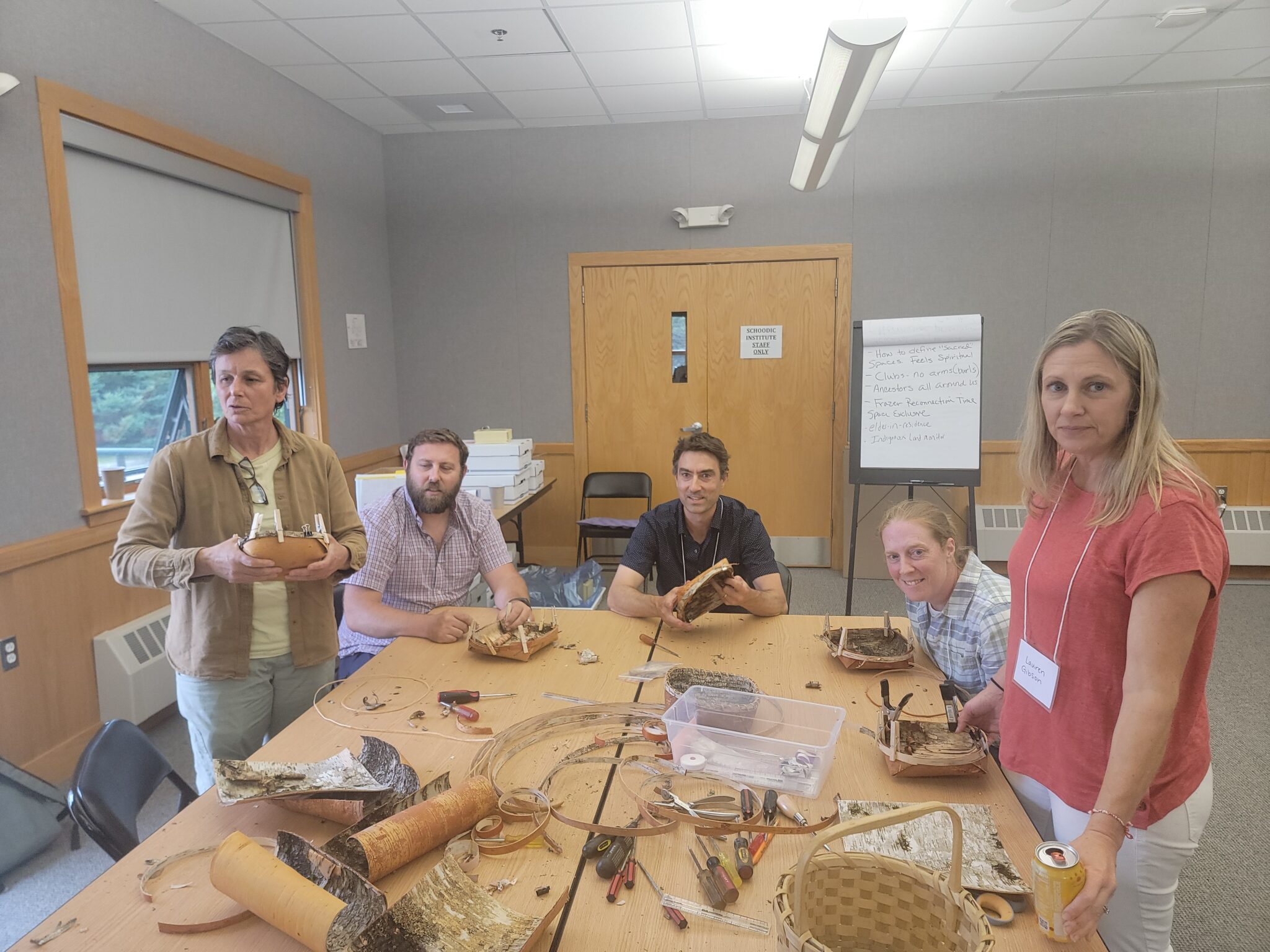
On the final morning, we went to Schoodic Point at dawn. We found a place on the rocks that faced the east. Some of us were visitors, others were at home. Together, we watched the sun rise.
Given its unique government-to-government relationship with Tribal Nations, the National Park Service can be and is a leader in figuring out how to collaboratively care for parks and protect them into the future. In Acadia, the gatherers have shown that Wabanaki cultural practices contribute to abundance and biodiversity. The archeologists have reconnected Wabanaki communities with gifts from their ancestors. Creating a path for Wabanaki people to renew relations with their home place does not mean that visitors can’t find their own healing, that other connections are not real. The Schoodic gathering, while a beginning, showed that when we work together – mawoluhkahtine – we can enrich the experience of Acadia for everyone.
